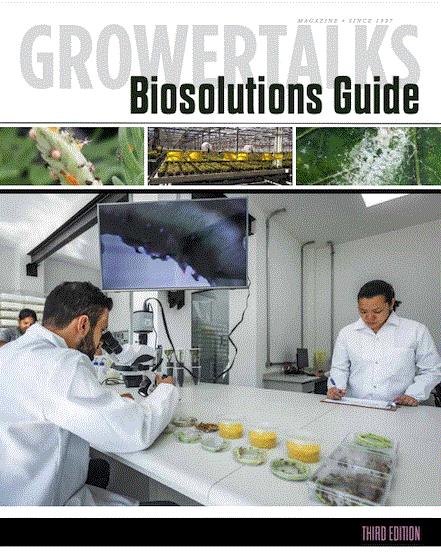AI Pest Control & In-House CO2 Win Awards
GreenTech Amsterdam took place in the Netherlands this week, and while most attendees are there for the trade show, the GreenTech Awards are always intriguing—looking at both products in concept and innovations hitting the market.
A platform that is meant to transform crop protection from reactive to preventative won the GreenTech Concept Award. ViewNetic is an AI-powered platform that is able to scout each individual plant and offer precise recommendations. Egon Janssen, chairman of the jury, noted, “This innovation could mark the beginning of chemical-free growing.”
The GreenTech Innovation Award went to Skytree Stratus, a machine that enables on-site CO₂ generation from ambient air. This compact machine is modular and scalable. Egon explained, “The jury recognizes CO₂ as a critical challenge in the transition to sustainable growing. Skytree has demonstrated an extraordinary pace in developing and scaling their technology. What truly sets them apart is not only the strength of their innovation, but also their strategic focus on the business case and their effective engagement with government stakeholders.”
You can learn more and view the other award nominees
HERE.

GrowerTalks Biosolutions Guide

The June issue of GrowerTalks includes the just-published third edition of GrowerTalks’ Biosolutions Guide. In addition to charts on bioinsecticides and biofungicides, you’ll find a number of expert articles covering supply chain and logistical issues, integrated management, and even how to test the quality of your biocontrol agents upon arrival. It’s a not-to-miss resource for anyone using or thinking about using biologicals in their growing operation.
You'll find your copy mailed with your June
GrowerTalks. Or you can download the digital version
HERE.
Organics, Chemicals and the MAHA Report
The report highlights four concerns: 1) The shift to ultra-processed foods, 2) the cumulative load of chemicals in our environment, 3) the crisis of childhood behavior in the digital age, and 4) the overmedicalization of kids. As you’d expect, crop protection tools make the list of chemicals of concern, and farming was identified as playing a critical role in the MAHA agenda. The report also takes issue with the safety and research on record for many pesticides and herbicides. The MAHA Commission is now charged with developing the strategy to address these issues in the report.
On one hand, the Organic Trade Association says that they’re encouraged to see the MAHA Commission affirm that health begins on the farm. “What we know is that organic farmers are already leading the way,” OTA said in a statement. “However, the report also reveals a critical challenge. In the section ‘Government Programs Compounding the Issue,’ it notes that in the most recent Farm Bill, support for organic and specialty crops like fruits, vegetables and nuts represented just 0.1% of total funding. This imbalance makes it difficult for organic producers to realize the full potential of organic.” OTA says the report’s recommendations do not address the need for greater investment in organic.
Meanwhile, many other ag interests worry the next strategic steps could involve restrictions on crop protection products. AmericanHort and other groups say the report is fear-based and unscientific and “could erode consumer trust and fuel litigation.” They also say the report unfairly questions the safety of pesticides despite decades of scientific evaluation and EPA oversight. AmericanHort recently stated, “AmericanHort, in conjunction with the Pesticide Policy Coalition, is determining next steps for advocacy efforts on Capitol Hill and in the Trump Administration about the impact limiting access to pesticides would have on the horticulture industry.”

Solar Panels Might Help in Dry Years
In the growing niche of agrisolar, folks are trying to figure out how solar panels can co-exist with agriculture. A new study out of Colorado State University and Cornell University indicates that solar panels can actually increase the productivity of grasslands directly underneath them during dry years.
A four-year study in semi-arid Colorado saw that fields with solar panels had reduced water stress and improved soil moisture levels. In a dry year, grass growth in those solar-panel fields increased by 20% compared to an open field with no solar panels. This particular study used a setup that prioritized energy production, but researchers say that the effect might be greater if the solar installations were designed to maximize grassland benefits.
Report from the MT Outpost

Montana has a way of feeling utterly decadent and lush in June, living up to the hype. Things are looking good at the Outpost, but my real confession is that the wildflowers outshine my cultivated gardens. It happens a little more each year. This week, it’s the flax. While my border garden is easing into its June blooms, the meadow of flax backing it is reaching its peak. About eight years ago, I seeded this bank with a native grass mix that included some flax seed, and those plants have matured into a sea of blue that resists the tunneling voles and glows bright every morning.
Until next time,

Jennifer Duffield White
jwhite@ballpublishing.com
This email received by 27,111 loyal readers!
Want to be one of the lucky sponsors who reach those readers of GreenTalks? Drop Paul Black a line and he’ll tell you what a bargain it is!
GreenTalks® is a registered trademark of Ball Horticultural Company in the U.S.